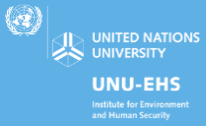Despite on-going adaptation efforts, vulnerable communities are experiencing climate-induced loss and damage that threatens their food security and livelihoods and forces them deeper into poverty, according to a research report by the UN University Institute for Environment and Human Security (UNU-EHS).
‘Pushed to the Limit: Evidence of climate change-related loss and damage when people face constraints and limits to adaptation' presents case studies from Burkina Faso, Ethiopia, Mozambique and Nepal that analyze the impacts of droughts and floods on households, primarily small-scale farmers.
 11 November 2013: Despite on-going adaptation efforts, vulnerable communities are experiencing climate-induced loss and damage that threatens their food security and livelihoods and forces them deeper into poverty, according to a report by the UN University Institute for Environment and Human Security (UNU-EHS). ‘Pushed to the Limit: Evidence of climate change-related loss and damage when people face constraints and limits to adaptation’ presents case studies from Burkina Faso, Ethiopia, Mozambique and Nepal that analyze the impacts of droughts and floods on households, primarily small-scale farmers.
11 November 2013: Despite on-going adaptation efforts, vulnerable communities are experiencing climate-induced loss and damage that threatens their food security and livelihoods and forces them deeper into poverty, according to a report by the UN University Institute for Environment and Human Security (UNU-EHS). ‘Pushed to the Limit: Evidence of climate change-related loss and damage when people face constraints and limits to adaptation’ presents case studies from Burkina Faso, Ethiopia, Mozambique and Nepal that analyze the impacts of droughts and floods on households, primarily small-scale farmers.
Despite applying adaptation and coping measures, 96% of surveyed households in Ethiopia, 78% in Nepal, 72% in Burkina Faso and 69% in Mozambique experienced negative impacts on their food security or livelihoods following climate-induced damage. Across the study, 75% of households reported modifying food intake as a result of increased drought and flood frequency or changing rainfall patterns. In Ethiopia, for example, severe floods resulted in large-scale crop destruction, which contributed to higher food prices that made staple foods unaffordable.
“Time and time again the study found that households that are already struggling are forced into deeper poverty due to climate change impacts,” said Fatima Denton, African Climate Policy Centre (ACPC), which collaborated with UNU-EHS on the African studies. Koko Warner, UNU-EHS, explained the findings show “current levels of adaptation and mitigation efforts are insufficient to avoid negative impacts from climate stressors.” Further, the report suggests people in vulnerable countries may be approaching adaptation boundaries, “beyond which climate change compromises sustainable development.”
The report also illustrates non-economic loss and damage. In Burkina Faso, lack of fodder and water decimated pastoralists’ herds, resulting in physical loss of cattle and in pastoralists’ loss of way of life and cultural identity because they had to move to urban areas or take up crop cultivation.
The report recommends discussions on institutional arrangements to address loss and damage at the 19th session of the Conference of the Parties (COP19) to the UNFCCC, facilitate transformations on, inter alia: discourse on risk response and management; international financial support; and international leadership and guidance in operationalizing climate risk management.
The report, Volume 2, builds on results from Bangladesh, Bhutan, Gambia, Kenya and the Federated States of Micronesia (FSM), published as Volume 1. Together, the reports show loss and damage occurs when adaptation limits are reached or exceeded and when barriers exist that hinder adaptation planning and implementation. [UNU Press Release] [Publication: Pushed to the Limit] [IISD RS Story on Volume 1]